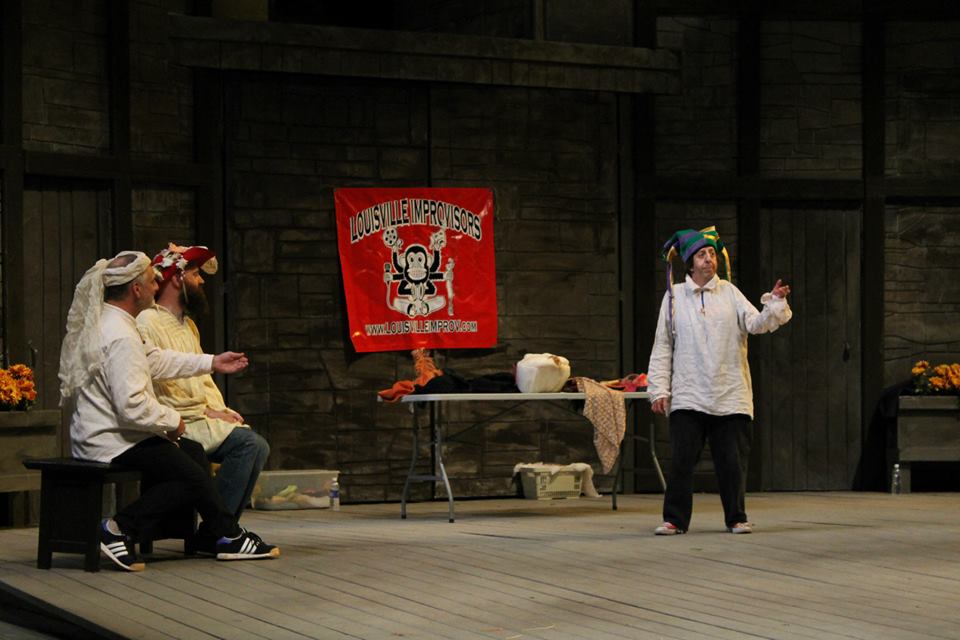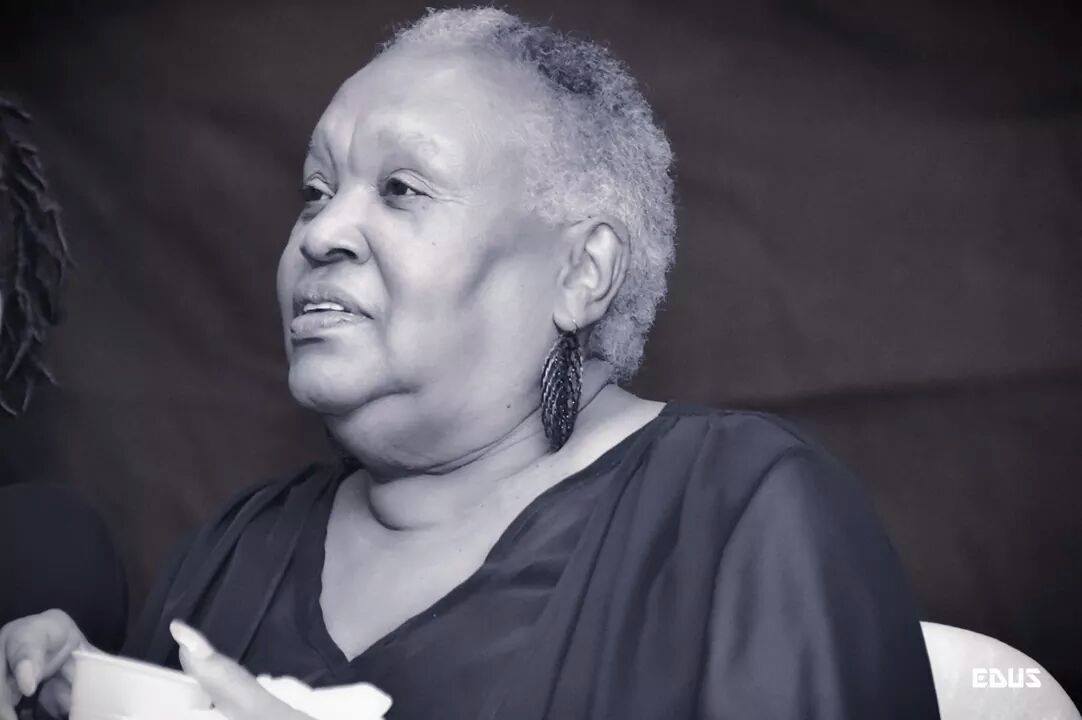Amanda Browning, Amber Marquez, & Theresa Bautista rehearsing Ila Conoley Paladino’s “Recycle Reality. Photo courtesy Moving Collective.
DECA
Moving Collective
Review by Kathi E.B. Ellis
Entire contents copyright © 2016 Kathi E.B. Ellis. All rights reserved.
Moving Collective celebrated ten years of existence this past weekend with an ambitious program of premieres at Vault 1031 in Old Louisville. The main performance room of the Vault was transformed into an intimate dance space, and the choreographers are to be commended for adapting the larger ensemble pieces to this stage.
The DECA program opened with the most satisfying work, “Lemmings Lament,” choreographed by Katie Kasari, who has also danced with Samovar Dance Company. The four dancers confidently explored the intentionally repetitive movements that bound the group together. Kasari creates a compelling, even impelling, group mentality in this piece – even when there is individual or paired movement, the dancers always come back to the full group. Her lifts are intricate and non-traditional, and contribute to the overall ‘group-think’ of the piece.
Each half of the program ended with two longer pieces, “Evensong,” and “Drive,” respectively. Both pieces suffered by being placed at the end of their chunk of programming, and would have benefitted from being positioned earlier in their sections. Amanda Browning’s “Evensong” is set to choral chants of Morten Lauridsen and Ola Gjeilo, and begins in what appears to be an expected atmosphere of contemplation. No program notes were included, but there appeared to be an implicit narrative in which grief and conflict were juxtaposed in ways that were not always clear. And, currently, it feels like the piece could have ended more than once.
Choreographer Meghen McKinley teaches at WKU and her dancers for “Drive” are from that program. Danced to the music of Warpaint, an all-girl band, this high energy piece was very busy and crowded (even with one dancer being absent) so that it was challenging to know where to focus, what was the most important grouping and/or sequence to watch.
“Recycle Reality,” choreography and costume design by Ila Conoley Paladino, is an intriguing piece with potential that wasn’t fully realized at Sunday afternoon’s performance. The bold blue, red, and yellow, attention-getting costuming suggest the upbeat quirky energy of this piece from the very beginning. Set to unidentified Mozart music, the three dancers on Sunday were not as sharply articulated as is the precision of the music; there were times when it was not clear if particular moves were unison, individual, or just not quite articulated enough to be clearly one or the other, or two together and one immediately before or after. Conoley Paladino is to be applauded for bringing the idea of audience participation into a genre that is typically presentational. This conceit needs to be honed more for it to play more successfully. The nature of the ‘improvisation’ was unclear, in part because only one of the three dancers verbalized clearly enough what were her instructions from the audience; if all three dancers speak their individual instruction so that the whole audience hears, then we’re in on the joke from the beginning and will be better able to appreciate the cleverness of the last three movements of the piece.
“space / separate” from danah bella, danced by Laura Barber, incorporated some of the most precise use of space and kinesthetics in the program. Barber completely embodies the juxtaposition suggested in this piece’s title, and realized by choreographer bella, hovering in an attitude until the last possible moment, and immediately cascading into another with no apparent ‘tell’ as to what the latter will be.
Amber Marquez’ “Solitary Suffering is my Vibe” offered a meditation, to a variety of music genres, on the isolation of contemporary society, especially with regard to technology and self image. Beginning with one performer on stage, applying make-up, and with the other three performers adding in individually, each iterating a movement sequence which suggested their particular hang-up, the piece gained in energy and intensity as they came together, each adopting all the others’ gestures en masse. The program note suggested that this collectivism could be calming and healing. On Sunday the affect was more frenetic, and authentically so, carrying with it the sense of the pressure to be complicit in the rush of today’s society.
“Paired but not Paired” was billed as being choreographed and performed by Moving Collective founder Theresa Bautista and Susie Thiel. Unfortunately Thiel was unable to perform at this performance, so the exploration of “duet” was absent from the performance. While the program note gave space for this to become a solo, there was a cognitive dissonance in continuing to include this piece with only one artist’s work. Nonetheless, Bautista’s performance was mesmerizing. The frequent use of slow-motion, extending a movement or attitude to the enth degree in time, became almost hypnotic, a reminder (as with “space / separate”) that one performer can command an audience’s attention as effectively as a large ensemble.
While the program listed the artists whose music was used in this program, there was no specific credit to the particular piece or to the artists performing it. In the case of Mozart and Gene Autry, they have a large canon, and it would be helpful to audiences to identify more specifically the musical inspiration.
Moving Collective is a player with longevity in the apparently expanding dance world of Louisville. There is, of course, the Louisville Ballet; Flamenco Louisville is also entering its second decade; the Kentucky Center is returning to modern dance programming. In addition, John Keen Dance has relocated to Louisville in recent years, Samovar Dance Company offers a fusion of Middle Eastern and other dance forms, Dreamland includes dance and performance art in its programming, and Camera Lucida explores the relationship between music, video and dance. With this diversity of dance already in our community, it’s to be hoped that more dance troupes take root and expand Louisville audience’s opportunities to engage with this dynamic art form.
DECA
February 27 & 28, 2016
Moving Collective
At Vault 1031
1031 South Sixth Street
Louisville, KY 40203
Movingcollective.com
Kathi E.B. Ellis is a member of the Lincoln Center and Chicago Directors’ Labs and an associate member of the Stage Directors & Choreographers Society. She has attended the LaMama Directing Symposium in Umbria, Italy, and is featured in Southern Artisty, an online registry of outstanding Southern Artists. Her directing work has been recognized with nominations for the South Florida Theatre Carbonell Award. Locally, Kathi is a member of Looking for Lilith Theatre Company, a founding principal of StageLab theatre training studio, and is part of ShoeString Productions an informal producing collective. She has written book reviews and articles for Southern Theatre, the quarterly publication of the Southeastern Theatre Conference, and was a contributing writer for JCPS’ textbook for the 11th grade Arts and Humanities survey course and for YouthArts Tapestry, a Kentucky Arts Council publication.




